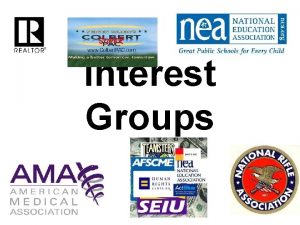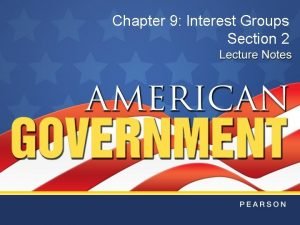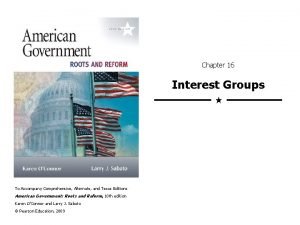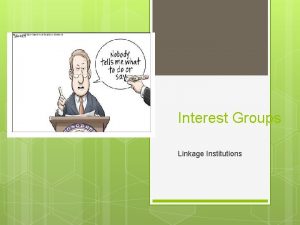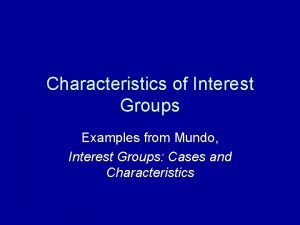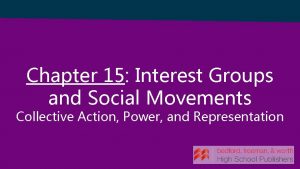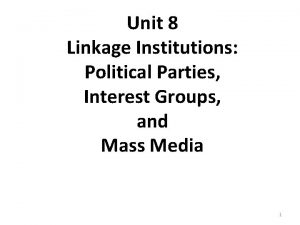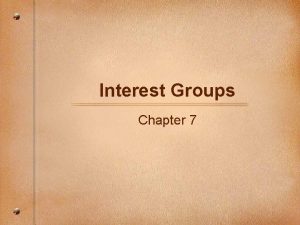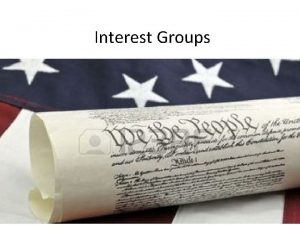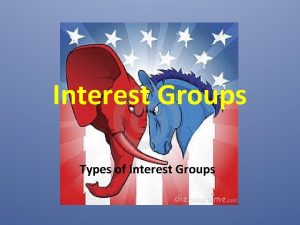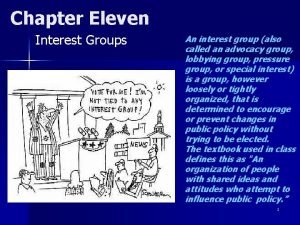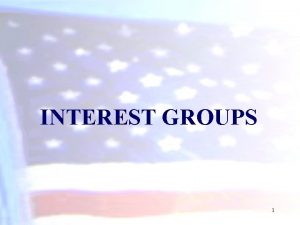Chapter Eleven Interest Groups Why Interest Groups are













- Slides: 13

Chapter Eleven Interest Groups

Why Interest Groups are Common • Interest group: any organization that seeks to influence public policy Copyright © Houghton Mifflin Company. All rights reserved. 2

Incentives to Join • Solidary incentives—pleasure, companionship • Material incentives—money, things, services • Purposive incentives—goal/purpose of the organization itself Copyright © Houghton Mifflin Company. All rights reserved. 3

Funds for Interest Groups • Foundation grants – One study found that 1/3 of public interest lobbying groups received more than half of all their funds from foundation grants • Federal grants and contracts Copyright © Houghton Mifflin Company. All rights reserved. 4

Funds for Interest Groups • Direct mail: through the use of computers, mail is sent directly to a specialized audience • But this approach is also expensive—it must generate checks from at least 2 percent of the people contacted Copyright © Houghton Mifflin Company. All rights reserved. 5

Money and PACs • Ideological PACs raise more money, but raising the money also consumes it, so less is available to give to campaigns and candidates • In 2003 -2004, unions and business or professional organizations gave the most • Incumbents get the most PAC money Copyright © Houghton Mifflin Company. All rights reserved. 6

Table 11. 3: Spending by Political Action Committees (PACs), 2003 -2004* Copyright © Houghton Mifflin Company. All rights reserved. 7

Activities of Interest Groups • Supplying credible information is the single most important tactic of interest groups • Some groups try for grassroots support • Legislative Ratings • Money Copyright © Houghton Mifflin Company. All rights reserved. 8

Money and PACs • PAC: a committee set up to raise and spend money on campaigns and candidates • Money is the least effective way to influence politicians Copyright © Houghton Mifflin Company. All rights reserved. 9

Money and Influence • There is no systematic evidence that PAC money influences votes in Congress • Most members vote in line with their ideology and with their constituents Copyright © Houghton Mifflin Company. All rights reserved. 10

Money and Influence • PAC money may influence politics in other ways, like access or committee actions Copyright © Houghton Mifflin Company. All rights reserved. 11

Regulating Interest Groups • A 1995 act provided a broader definition of lobbying and tightened reporting requirements • Tax code; nonprofits lose tax-exempt status if a “substantial part” of their activities involve lobbying • Campaign-finance laws limit donations by individual PACs Copyright © Houghton Mifflin Company. All rights reserved. 12

Why Interest Groups are Common • The Constitution provides many access points to government • Political parties are weak so interests work directly on government Copyright © Houghton Mifflin Company. All rights reserved. 13
 Insidan region jh
Insidan region jh Hey bye bye
Hey bye bye Why are interest groups important
Why are interest groups important Chapter 9 section 1 the nature of interest groups
Chapter 9 section 1 the nature of interest groups Chapter 9 section 2 types of interest groups
Chapter 9 section 2 types of interest groups Dont ask
Dont ask How are ethnic groups and religious groups related
How are ethnic groups and religious groups related The nature of interest groups
The nature of interest groups A virtue of interest groups is that
A virtue of interest groups is that Linkage institutions examples
Linkage institutions examples Proliferation of interest groups
Proliferation of interest groups State two characteristics of interest groups
State two characteristics of interest groups Interest groups vs social movements
Interest groups vs social movements Linkage institutions definition
Linkage institutions definition



